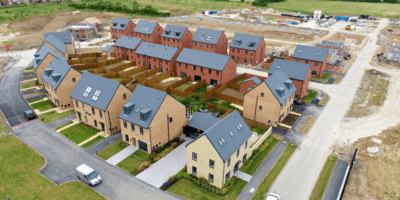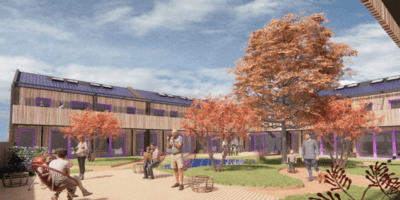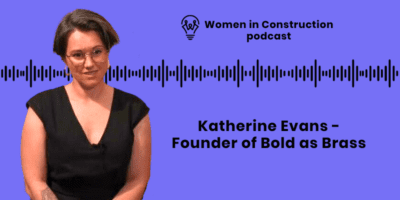Sandi Rhys Jones OBE is president of the Chartered Institute of Building, the CIOB, and she is the 120th person to hold the position. Sandi began her career in construction, property and engineering as a journalist, working for a variety of technical organisations before forming her management and marketing business. Now an experienced non-executive director, she has worked for contractors, consultants, suppliers, representative organisations and government, both in the UK and overseas, focusing on performance improvement and business development, having been appointed OBE in 1998 for her work in promoting women in construction.

“Ambitious employers recognise the need to attract and retain a diverse and talented pool of professionals for the best chance of success in global markets.”
The eureka moment
Like so many people, my career in construction happened by chance. I was always fascinated by making things (my father, an engineer, taught me woodworking, decorating and how to wire a plug etc. when I was very young). But the headmistress of my all-girls grammar school was convinced that I should study and then teach classics, taking a visit from my father to insist that I be allowed to sit GCSE sciences as well as Latin and arts subjects. Looking back, I realise that neither I nor my parents appreciated that what you studied at university need not dictate your career — which is why I am passionate about improving career advice, particularly in support of construction as a viable career.
So, as a headstrong 16-year-old, I decided to leave after two terms of A-levels, and after a year as a civil servant headed for London, got a job with the global advertising agency J Walter Thompson (heady times in the sixties) and then was offered a job with the weekly newspaper, Construction News. This was the eureka moment that led to my long career in construction, property and engineering, starting as a journalist working for a variety of technical organisations before forming my management and marketing business with my civil engineer husband.
The gateway to a fascinating and rewarding international career
For me, construction has been the gateway to a fascinating and rewarding career that has taken me around the world. I have worked with contractors, consultants, suppliers, representative organisations and government, both in the UK and overseas, focusing on performance improvement and business development, contracts and procurement, conflict management, culture change and talent management. I have also served as a non-executive director in a range of private, public sector and not-for-profit organisations.
At the same time as running the business, we took on and restored crumbling period homes, helped to regenerate our local area, bought an office building off plan as well raising three sons — and I remain a self-confessed, hands-on compulsive builder.
I also continued with my professional education, becoming a Fellow of the Chartered Institute of Building, a Fellow of the Women’s Engineering Society, a member of the Chartered Institute of Marketing and an Associate of the Chartered Institute of Arbitrators. Despite not having a first degree, I successfully undertook the MSc course in Construction Law & Arbitration at Kings College London and then trained as a mediator. I am honoured to have received two honorary doctorates, from Sheffield Hallam University and from the University of Westminster.
A passionate advocate for the built environment, I have served on many government/industry working groups and was appointed OBE in 1998 for promoting women in construction.
Improving the quality of life for those using and those creating the built environment
The CIOB is the world’s largest and most influential professional body for construction management and leadership, its core aim to improve the quality of life for those using and for those creating the built environment. Particularly important for me is that it is a very broad church, with over 47,000 members worldwide drawn from across the many and varied disciplines involved in delivering the buildings and infrastructure that are essential to society – there are more than 80 different built environment roles represented within our membership.
CIOB has a Royal Charter which requires us to work in the public interest, to drive quality, and set standards, while we operate as a professional body, educator, policy influencer, and campaigner.

As president, I am committed to helping our profession create an environment in which society can live and work safely, comfortably, and confidently. The big themes in the CIOB corporate plan address sustainability, quality and safety, and attracting and keeping the skills we need. My personal theme is to do this collaboratively, working across disciplines, sectors, and cultures – we can’t do this in silos.
Employers ignore diversity and inclusion at their peril
Construction suffers from a lack of diversity. Long regarded as a white male-dominated industry, there have been many initiatives to try to bring about change. It’s important to remember why this lack of diversity is a problem, and in simple terms, it means employers are missing out; missing out on innovation, missing out on different viewpoints and missing out on creativity, all of which are needed for a company to be truly successful, not just in terms of profitability but also employee wellbeing and client satisfaction.
Ambitious employers recognise the need to attract and retain a diverse and talented pool of professionals for the best chance of success in global markets. At CIOB, we believe a built environment for diverse communities can only be achieved if the people designing and creating those environments are as diverse as the communities themselves.
Inclusion, the obvious solution to tackle the ongoing construction skills shortage
My dissertation for the MSc in construction law made the point that construction has a reputation for being dirty, dangerous, expensive, slow, and combative – and is the industry with fewer women than any other bar mining. Since then, there has been change but the figures remain very low and women are still under-represented.
The figures CIOB has quoted for a couple of years are from ONS [Office for National Statistics] data and put the number of women in the industry in the UK at around 12-13% — however, another survey published in August indicates a figure of 18%, which is good news. But figures also vary across disciplines and stages of career, for example, 50% of architectural students are female but far fewer are practising. One thing is certain, the number of women in the crafts and trades working on site is embarrassingly low – 2%, so an imbalance most definitely exists. This stark under-representation points to one obvious solution to the current and ongoing skills shortage in the construction sector.
Fostering more diverse and inclusive workspaces
As a long-time campaigner for greater diversity, I was delighted that in 2021 CIOB employed a full-time head of equality, diversity and inclusion (ED&I) transformation. Later that year our Diversity and Inclusion Charter was launched asking employers in the built environment to sign up to five actions to foster a more diverse and inclusive workspace.
More than 200 companies have signed the charter and committed to showing leadership, planning and creating a welcoming culture, and being transparent and accountable for their own progress. By signing up they’re demonstrating to potential recruits they want to attract the best talent from all walks of life which it’s recognised improves employee belonging and enhances credibility with clients. It shows the willingness to progress is there but there’s still so much to do.
We have also set up a Memorandum of Understanding across the built environment sector with five sister professional bodies to help gather consistent and robust information – you can’t measure progress if you don’t have reliable statistics.
Why we all deserve #PPPthatfits
This year the CIOB launched an initiative to address widespread inequalities in PPE provision across the industry, highlighting how this is having an impact on site safety and hampering the industry’s ability to attract and retain a more diverse workforce. The #PPEthatfits campaign shines a light on the lack of inclusive PPE in the market.
The campaign calls for PPE that fits the wearer properly – regardless of their gender, culture, religion, size or shape – is safe and complies with health and safety regulations. Through it we are encouraging people working in construction who have experienced inadequate PPE to share their experiences and ideas for change.
The current shortcomings in PPE provision are nothing new for many women working in construction. There have been efforts over some years by individuals and groups to encourage manufacturers and employers to provide properly fitting safety boots for example, but procurement habits, and the ‘pink it and shrink it’ strategy adopted by many suppliers is not an adequate approach to keeping the female workforce safe – not to mention visitors to site.

Research carried out by CIOB earlier this year revealed that 46% of respondents (both male and female) said the PPE they were given did not fit properly, while almost half of female respondents said they never wear PPE specially designed for women.
I am delighted that momentum is really building with this campaign and we have now produced a directory of manufacturers who produce ranges of PPE that are properly designed for women and other under-represented groups in construction (available here: https://ppethatfits.com/directory/
We are also collaborating with BSI [British Standards Institution] to produce guidance manuals and standards.
Get involved
We very much welcome any additional support for our #PPEthatfits campaign and encourage people to share their experiences via the campaign website: www.ppethatfits.com
We know the PPE issue isn’t specific to people in the construction sector, so we’d love to hear from those in other sectors too. Anyone can join the conversation on social media using the hashtag #PPEthatfits.
Coming up next
I am really looking forward to the rest of the presidential year — the first four months have gone in a flash — working with the great team and family of CIOB and particularly with the unprecedented and amazing cohort of women presidents and CEOs of sister organisations in the built environment, including: the Royal Institution of Chartered Surveyors; the Royal Institute of British Architects; the Royal Town Planning Institute ; the Landscape Institute; the Association for Project Management ; Local Authority Building Control; and the Federation of Master Builders.
Now is the time to harness our voices, abilities, and experience to shift the dial on the big issues, from making our homes fit for sustainable living, as well as building new ones, to helping to keep small and medium businesses alive and showing that construction is an enticing career. Oh, and I have a project at home that I really want to take forward in the next few months, involving earthmoving and retaining walls, with maybe a couple of pigs to help clear the ground ready for planting an orchard and kitchen garden.
Main image background: Image by Chuttersnap on Freepik





